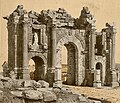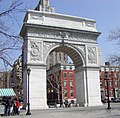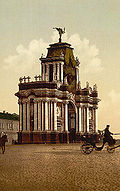Triumphal arch
A triumphal arch is a structure in the shape of a monumental archway, usually built to celebrate a victory in war. The arch is invariably a free-standing structure, quite separate from city gates or walls. In its simplest form a triumphal arch consists of two pillars connected by an arch, crowned with a superstructure or attic on which a statue might be mounted or which bears commemorative inscriptions. More elaborate triumphal arches have flanking subsidiary archways, typically a pair.
The rhythmic ABA motif— of central arched void flanked by smaller ones— was adapted in Classical architecture, particularly since the Renaissance, to articulate the walls of structures. The voids may take the form of niches or be "blind", with masonry continuous behind.
Roman triumphal arches
The tradition dates back to Ancient Rome and is connected to the Senate's custom of granting Roman triumphs. Surprisingly little is known about how the Romans used triumphal arches; the only ancient author who discussed them was Pliny the Elder, writing in the first century AD. They are not mentioned at all by Vitruvius, the first century BC writer on Roman architecture. Pliny describes them as being honorary monuments of unusual importance, erected to commemorate triumphs. By the second century arches were being erected to commemorate other events, such as the surviving triumphal arch at Ancona, erected by a grateful city to commemorate Trajan's improvements to the harbor.
It is unclear when the Romans first began erecting triumphal arches. They originated some time during the Roman Republican era, during which time three were erected in Rome, the earliest being one to Lucius Stertinius built in 196 BC. These appear to have been temporary structures, and none now survive. Most triumphal arches were built during the Roman Empire. By the fourth century, thirty-six triumphal arches can be traced in Rome. Only five now survive (see list below).
The arches of Rome became increasingly elaborate over the centuries. They were at first very simple symbolic temporary gateways to the city, being built of brick or stone with a semicircular arched heading and hung with trophies of captured arms. Later arches were built of high-quality marble with a large central arch in the middle, its ceiling treated as a barrel vault, and sometimes two smaller ones on each side, adorned with a complete Architectural order, of columns and entablature, enriched with symbolic or narrative bas-reliefs and crowned with bronze statues, often a quadriga. The festive Corinthian order was the usual one.
Post-Roman triumphal arches
Triumphal arches in the Roman style were revived during the Renaissance, when there was a Europe-wide upwelling of interest in the art and architecture of ancient Rome. Between the 16th and 19th century, kings and emperors erected numerous triumphal arches in conscious imitation of the Roman tradition. One of the earliest was the temporary arch erected in Rome to celebrate the election in 1513 of Pope Leo X. The Emperor Maximilian I commissioned the artist Albrecht Dürer to design an elaborately decorated monumental arch for him, though it was never actually built. Louis XIV of France and Napoleon Bonaparte both erected arches to commemorate their military triumphs, most famously the Arc de Triomphe in Paris. Arches were erected for similar purposes in England, the United States, Germany, Romania, Russia and Spain, amongst other countries. Built to honour and glorify President Kim Il Sung and modeled after the Arc de Triomphe in Paris, the Arch of Triumph in Pyongyang is the largest arch in the world.
Temporary triumphal arches are still constructed, intended to be used for a celebratory parade or ceremony and then be dismantled afterwards.
List of triumphal arches
For Roman ones only, see List of ancient Roman triumphal arches
Permanent monumental triumphal arches include:
- Arch of the Cinquantenaire, Brussels (erected 1880-1905)
- Menin Gate, Ypres
- Marble Arch, London
- Wellington Arch, Hyde Park Corner, London
- Dijon: Porte Guillaume
- Marseille: Porte d'Aix (1825)
- Montpellier: Porte du Peyrou (1692)
- Nancy: on Place Stanislas
- Orange
- Paris:
- Arc de Triomphe (1806-1836)
- Arc du Carrousel (1806-1808)
- Grande Arche, La Défense (1982-1989)
- Porte Saint-Denis
- Porte Saint-Martin
- Reims: Porte de Mars
- Saint Rémy de Provence: Roman site of Glanum
- Saintes: Arch of Germanicus
- The Brandenburg Gate, Berlin, contrary to popular belief, is not a triumphal arch.
- Siegestor, Munich (1843-1850)
- Triumphtor, Potsdam
- Triumphal Arch, Vác
- Rome
- Arch of Constantine, Rome erected 312 - 315
- Arch of Drusus, Rome, erected to honor Nero Claudius Drusus
- Arch of Gallienus, Rome
- Arch of Septimius Severus, Rome, erected 203
- Arch of Titus, Rome (81)
- Arch of Janus, Rome
- Arch of Trajan, Ancona, erected 113
- Augustan Arch, Aosta
- Arch of Trajan, Beneventum, the Porta Aurea, erected 114
- Arco Campano, Capua
- Arch of Augustus, Fano
- Arch of the House of Lorraine, Florence, erected 1738 - 1759: the first freestanding permanent triumphal arch in Italy since Antiquity
- Arco della Pace, Milan, erected 1807 - 1838
- Triumphal arch of the Galleria Vittorio Emanuele II, Milan
- Arch of Augustus, Rimini, erected AD 27
- Arch of Augustus, Susa, erected 7 BC
- Arco dei Gavi, Verona
- Monumento ai caduti, Genoa
- Arco romano a colle San Giusto, Trieste
- Arch of Tiberius, Leptis Magna, erected 35 CE
- Arch of Septimius Severus, Leptis Magna
- Triuphal arch, Chişinău.
- Triuphal arch, Volubilis.
- Red Gate, Moscow - demolished
- Triumphal arch on Poklonnaya Hill, Kutuzovskiy prospekt, Moscow
- Moscow Triumphal Gate, St Petersburg
- Narva Triumphal Gate, St Petersburg
- Omsk, Tara gate
- Triumphal Arch of the General Staff Building in Palace Square
- Cossack triumphal arches in Novocherkassk
- Orlov gates, Gatchina
- Arc de Triomf, Barcelona
- Puerta de las Granadas, Granada
- Puerta de Alcalá, Plaza de la Independencia, Madrid
- Arco de la Victoria, Madrid
- Anazarbus
- Hadrian's Gate
- The Golden Gate in the Yedikule
- Arch of Catherine the Great, Novgorod-Seversky
- Monumental Arch, Galveston, Texas (1987-1990)
- Newport News Victory Arch, Newport News, Virginia
- Soldiers and Sailors Memorial Arch, Grand Army Plaza, Brooklyn, New York
- Tilton Memorial Arch, Tilton, New Hampshire
- Washington Square, New York, New York
See also
Gallery
-
The Arch of Constantine, Rome
-
The triumphal arch of Glanum
-
The Brandenburg Gate
-
Triumphal arch on Kutuzovsky Prospekt in Moscow
-
Puerta de Alcalá is a triumphal arch forming a monumental gateway to Madrid
-
Narva Triuphal Gates in St. Petersburg
-
The triumphal arch erected to honor Hadrian who visitied Antalya in 2nd century A.D.
-
The Washington Square Arch, New York City
-
Triumfal arch, center of Chişinău
-
Arch of Hadrian in central Athens, with the Acropolis seen in the background.
-
The Arc de Triomf in Barcelona
-
Arch 22 in Banjul, Gambia
-
The Arco do Triunfo in Lisbon
-
Temporary triumphal arch commemorating election of Emilio Aguinaldo as President of the Philippines, 1899
External links
- Lacus Curtius website: "Triumphal arch" from William Smith, A Dictionary of Greek and Roman Antiquities, John Murray, London, 1875
















